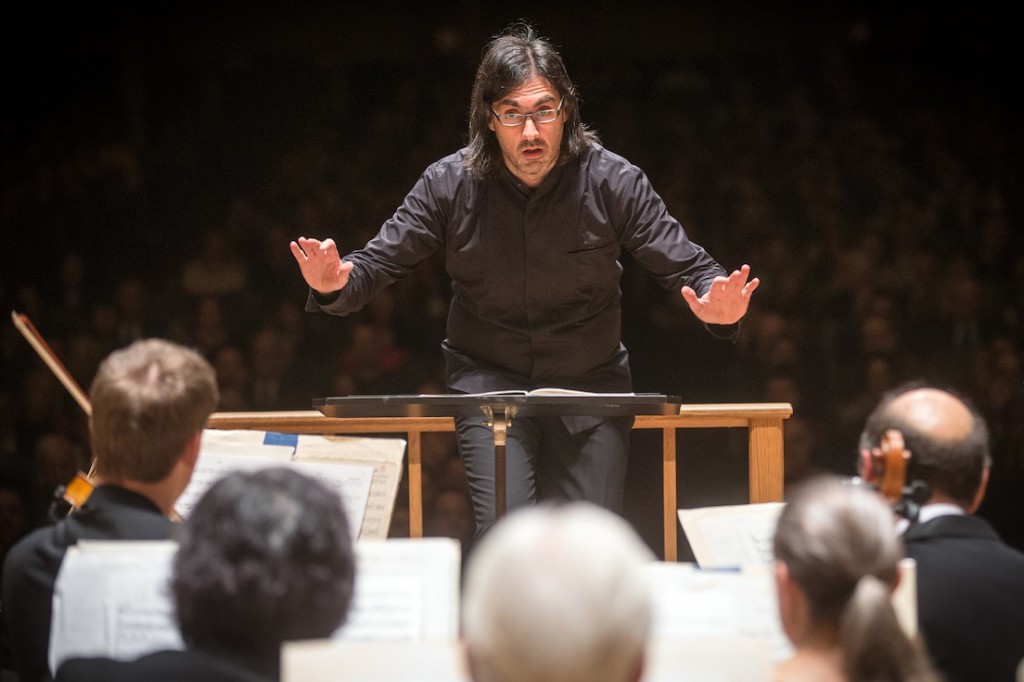Kavakos’s BSO program offers mixed rewards

Violinist-conductor Leonidas Kavakos led the BSO Tuesday night at Symphony Hall. Photo: Aram Boghosian
After two weeks of concerts that included premieres under the much-publicized leadership of Andris Nelsons, the Boston Symphony Orchestra settled into business-as-usual Tuesday night at Symphony Hall.
The evening proved a familiar one on two fronts. First, Leonidas Kavakos made his annual appearance with the orchestra in a dual role as violinist and conductor. And second, the program—Bartok’s Two Portraits, Haydn’s Symphony No. 82, and Ravel’s orchestration of Mussorgsky’s Pictures at an Exhibition—was certainly a safe one, though it managed to deliver rather uneven musical rewards.
As a violinist, Kavakos boasts a dexterous technique and a glowing tone. But as a conductor, he often is an awkward presence, leading with swaying, scooping, and even flapping gestures. Personal podium style aside, he managed to bring out the soft textures and delicate inner voices Tuesday night.
Ravel’s orchestration of Mussorgsky’s Pictures at an Exhibition has a long history with the Boston Symphony Orchestra. It was written specifically for Serge Koussevitzky, and the conductor’s frequent programming and famed recordings of the work with the BSO helped solidify this colorful suite as a major repertoire item.
That history makes it a challenge for any conductor stepping onto the podium to present Pictures at an Exhibition in a fresh new light, but Kavakos’ reading proved the evening’s highlight, revealing how remarkable and intricately orchestrated this suite really is.
The BSO, for the most part, was in fine form, with the brass playing the opening “Promenade” with golden tone and smooth phrasing. The melody of “Il vecchio castello” was haunting in its solos for bassoon and alto saxophone. The “Ballet of the Chicks in Their Shells” twittered with woodwind filigree. “Bydlo” bumped along like an ox-drawn cart, the solo tuba soaring with mournful tone over the chugging strings. The angular lines of “Gnomus” galumphed appropriately, while those of “The Market at Limoges” seemed to laugh due to the sprightly playing from the winds and strings.
The only mistake—and it was a big one—took place when the solo trumpet flubbed the solo in “Samuel Goldenberg and Schmuyle,” dropping out entirely after a few unfocused utterances.
Fortunately, the orchestra pulled together for the pieces that close the suite. The musicians dug in for a thunderous rendering of the “Hut of Baba Yaga,” and the opening phrases of the “Great Gate of Kiev” unfolded elegantly in the brass as if the gate itself was materializing in the distance.
Kavakos’ skills as a soloist were in display in Bartók’s Two Portraits, which opened the concert.
Composed in 1908, the Two Portraits encapsulate, in music, Bartók’s romantic feelings for the violinist Stefi Geyer. The first of the set, which also appears as the first movement of the composer’s First Violin Concerto, is a lushly scored piece for violin and orchestra and featured Kavakos in a flowing, silvery line. The BSO’s violins, arranged on either side of the stage to create an antiphonal effect, entered two at a time to spin delicate melodies around the soloist. As the music progressed, Kavakos darkened his phrases with an amber-rich tone, the orchestra all the while laying down a feathery accompaniment.
The second of the Two Portraits is a brief but entertaining grotesquerie where melodies seem to start and stop fitfully. Kavakos’ reading carried over the smooth treatment of the previous movement, but, unfortunately, failed to mine much humor from the music.
The same staid energy also characterized Tuesday night’s performance of Haydn’s Symphony No. 82.
The first of the composer’s Paris Symphonies, the work, later nicknamed “the Bear,” is filled with phrases of rolling energy. Some of that was evident in the Kavakos’ handling of the first movement. Conducting without a baton, he took care to bring out the music’s inner parts, punctuating a brass call here and pulling out a trickling woodwind line there. Missing from this performance was the pulsing energy so characteristic of the symphony. The orchestra, with smooth playing, pieced all of the parts of the movement together, but the music failed to lift off.
The finale, with its drones and steamrolling themes, fared better and had the feel of rustic dance music, though communication between winds and strings were sometimes marred by untidy playing. The flutes and oboes, however, had a splendid evening on their own as they gave their parts a bubbling vitality. Fine playing all around marked the symphony’s inner movements. The orchestra rendered the lyrical second with stately grace, and the minuet sounded with regal pomp.
The program will be repeated 1:30 p.m. Friday and 8 p.m. Saturday at Symphony Hall. bso.org; 617-266-1492.
Posted in Performances



